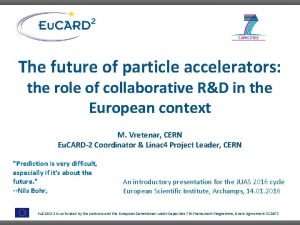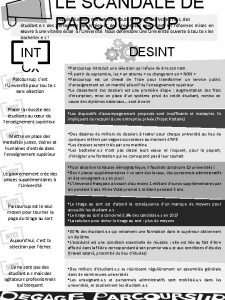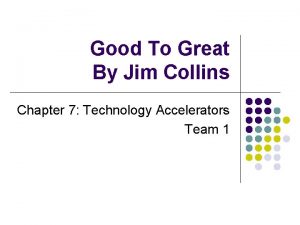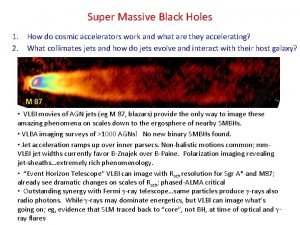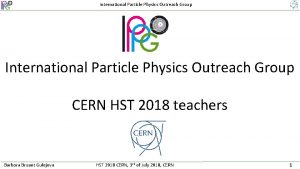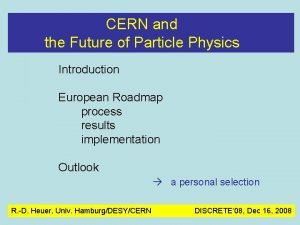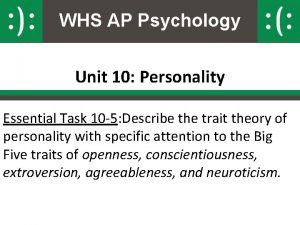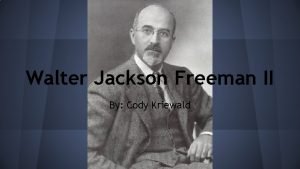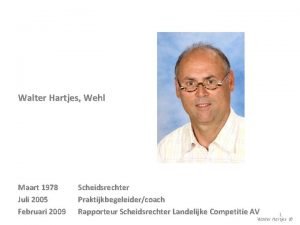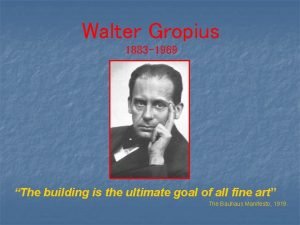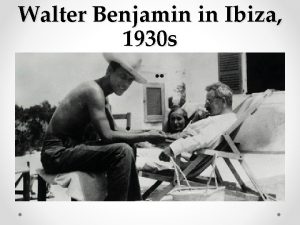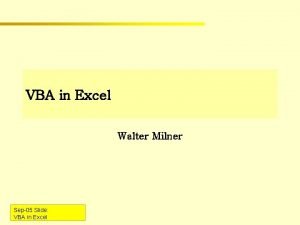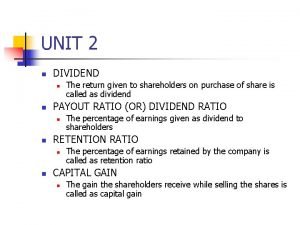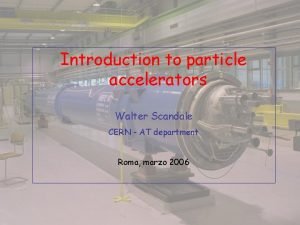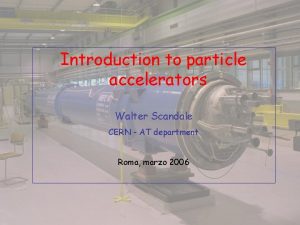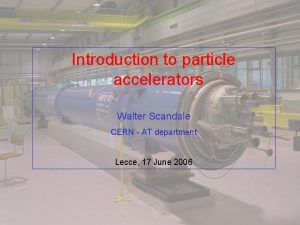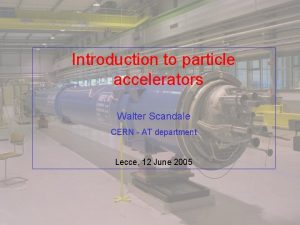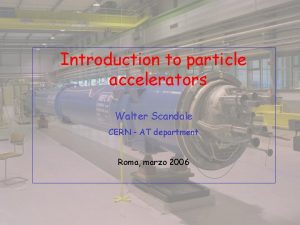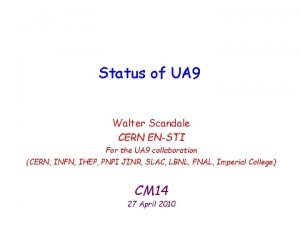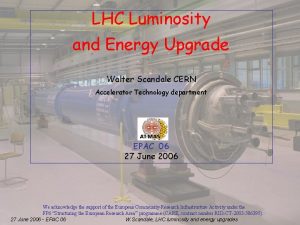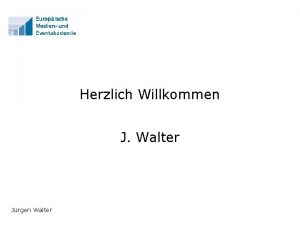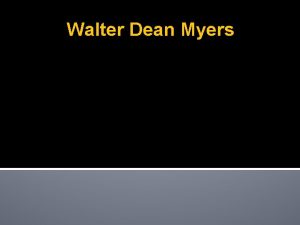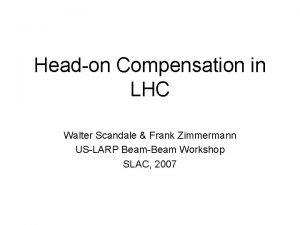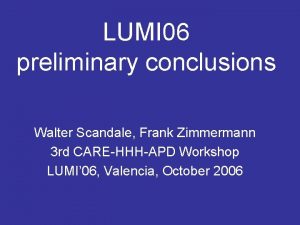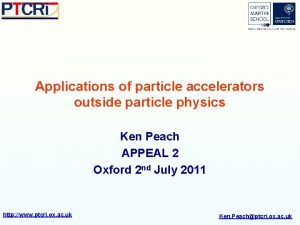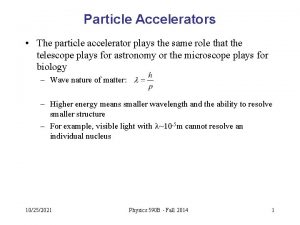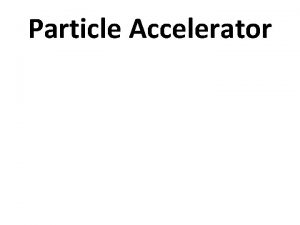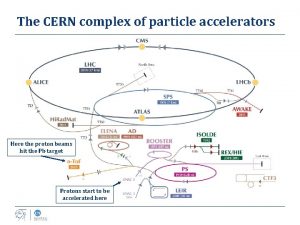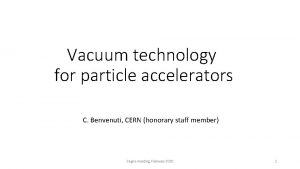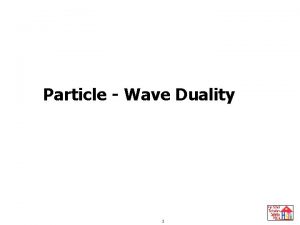Introduction to particle accelerators Walter Scandale CERN AT






























- Slides: 30

Introduction to particle accelerators Walter Scandale CERN - AT department Roma, marzo 2006

Lecture III - superconducting devices topics Limitations of normal conducting dipoles u Superconducting material properties u Critical temperature n Type I and type II superconductors n Theoretical approaches n l Meissner effect l Cooper pairs and BCS theory n u SC dipoles n n n u Mg. B 2 and HTS Current density Magnetization Flux jumping Quenches Wires and cables SC-RF

Dipoles Iron yoke reduces magnetic reluctance (reduced power and ampere-turns) -> small gap height u Field quality -> determined by the pole shape u Field saturation -> 2 Tesla (BEarth = 3 10 -5 Tesla) u B > 2 Tesla -> use SC magnets BLHC = 8. 4 Tesla u Abolish Ohm’s Law! no power consumption (although do need refrigeration power) u high current density u ampere turns are cheap, so we don’t need iron (although often use it for shielding) u Consequences Powering a resistive magnet u u u u lower power bills higher magnetic fields -> reduced bending radius I ≈ 5 k. A for 1. 8 T Ü smaller rings I ≈ 3· 105 A for 10 T Ü reduced capital cost R ≈ 1 m Ü new technical possibilities (eg muon collider) P = R·I 2 u higher quadrupole gradients PLEP = 20 k. W/magnet Ü higher luminosity PLHC = 100 MW/magnet (if resistive)

What is a superconductor Resistance of Mercury falls suddenly below measurement accuracy at very low temperature K. Onnes 1911

Short history of superconductivity u 1908 Heinke Kemerlingh Onnes achieves very low temperature producing liquid He (< 4. 2 K) u 1911 Onnes and Holst observe sudden drop in resistivity to essentially zero SC era starts u 1914 Persistent current experiments (Onnes) u 1933 Meissner-Ochsenfeld effect observed u 1935 Fritz and London theory u 1950 Ginsburg - Landau theory u 1957 BCS Theory (Bardeen, Coper, Schrieffer) u 1962 Josephson effect is observed u 1967 Observation of Flux Tubes in Type II superconductors (Abrikosov, Ginzburg, Leggett) u 1980 Tevatron: The first accelerator using superconducting magnets u 1986 First observation of Ceramic Superconductor at 35 K (Bednorz, Muller) u 1987 first ceramic superconductor at 92 K (above liquid Nitrogen at 77 K !) HTS era starts u 2003 discovery of a metallic compound the B 2 Mg superconducting at 39 K (x 2 Tc of Nb 3 Sn) n It took ~70 years to get first accelerator from conventional superconductors. n How long will it take for HTS or B 2 Mg to get to accelerator magnets? Have patience!

What is a superconductor Below the critical temperature Tc the resistivity drops Cooper pair appearance Below Tc the B-field lines are expelled out of a superconductor (perfect diamagnetic behaviour) Meissner 1933 phonon-einteraction Type I superconductors the superconductivity disappears as T > Tc | B > Bc | J > Jc Type II superconductors For Bc 1 < Bc 2 there is a partial flux penetration through fluxoid vortexes and a mixed phase B=0 T < Tc B < Bc

Meissner effect and magnetization u u u Inside the SC material one has B = 0 E = 0 (otherwise there is an infinite current flowing !) There is a superficial screening current inducing a diamagnetic polarization M = -H/4 p = c. H The B field penetrate with an exponentially decaying intensity B(s) = B(0)exp(-s/l. L)

BCS theory Normal conducting state Superconducting state u Tc ~ 1/ √Misotopic -> phonons should play a role in superconductivity u Creation of Cooper pairs (over-screening effect) n n n u In An e- attracts the surrounding ion creating a region of increased positive charge The lattice oscillations enhance the attraction of another passing by e - (Cooper pair) The interaction is strengthened by the surrounding sphere of conduction e - (Pauli principle) a superconductor the net effect of e-e- attraction through phonon interaction and the e-e- coulombian repulsion is attractive and the Cooper pair becomes a singlet state with zero momentum and zero spin u To break a pair the excitation energy is ∆E = 2∆

Energy bond of a Cooper pair Pr BC S t i ob n t heo le he ry ms c N wi era OT th m SC ic S vali ty C. d pe II Predictions of the BCS theory Size of a Cooper pair 100 nm Lattice spacing 0. 1 ÷ 0. 4 nm

More on type I and II superconductors Note: of all the metallic superconductors, only Nb. Ti is ductile. All the rest are brittle intermetallic compounds Type I: not good for accelerator magnets Type II: allow much higher fields u u u Also known as the “soft superconductors”. Completely exclude the flux lines. Allow only small field (Bc < 0. 1 T). n In accelerator magnets only Type II Low Temperature Superconductors are used. n Nb. Ti, a ductile material, is the conductor of choice so far to build SC accelerator magnets. n Nb 3 Sn (higher Bc 2) is the only very promising conductor future higher field magnet. However, Nb 3 Sn is brittle nature and presents many challenge in building accelerator magnets. u u Also known as the “hard superconductors”. Completely exclude flux lines up to Bc 1 but then part of the flux enters till Bc 2 Examples: Nb. Ti, Nb 3 Sn

Physics of type I and II superconductors u “London Penetration Depth” l. L is the e-fold decay length of the magnetic field from the superconductor skin due to the Meissner effect (in the range of 10 to 103 nm) u “Coherence Length” x the average size of Cooper in the superconductor (in the range of 10 to 100 nm, I. e. much larger than the interatomic distance typically of 0. 1 to 0. 3 nm. Ginzburg-Landau Parameter k

More on fluxoids Fluxoids consist of resistive cores with super-currents circulating round them. a single fluxoid encloses flux spacing between the fluxoids Fluxoid patter in Nb Fluxoid motion due to current flow in Nb (SC type II)

The Magnesium Diboride Mg. B 2 The magnesium diboride Mg. BDiscovered in January 2001 (Akimitsu) LTS with Tc: ~39 K A low temperature superconductor with high Tc u u u The basic powder is very cheap, and abundantly available. The champion performance is continuously improving in terms of Jc and Bc. However, it is still not available in sufficient lengths for making little test coils.

The high temperature SC (HTC) u u u many superconductors with critical temperature above 90 K - BSCCO and YBCO operate in liquid nitrogen? Unlike the metallic superconductors, HTS do not have a sharply defined critical current. At higher temperatures and fields, there is an 'flux flow' region, where the material is resistive - although still superconducting The boundary between flux pinning and flux flow is called the irreversibility line metallic HTS

SC dipole d -J +J real xsection I I I B saddle shaped long dipole coils to make more uniform fields u some iron - but field shape is set mainly by the winding u for good uniformity need special winding cross sections u simplest winding uses racetrack coils

Current density u u In pure SC filament -> J ~ 3 k. A/mm 2 In the real world replace J -> Jeng the 'engineering' current density u Wire: enough copper to provide stability (Cu/SC ≈ 1. 7) n against transient heat loads n to carry the current in the event superconductor turns normal. Cable: the trapezoidal “Rutherford cable” is made of several round wires (filling factor ~ 0. 9) u Coil: it consists of many turns. There must be a turn-to turn insulation (filling factor ~ 0. 85) Nb. Ti u Cu Current density in wires and cables of Nb 3 Sn insulation

Flux jumping a problem solved using fine SC filaments u u u When the B-field raises, large screening current are generated to oppose the changes. The current densities are initially much larger than Jc which will create Joule heating. The large current soon dies and attenuates to Jc, which persist. Screening currents are in addition to the transport current, which comes from the power supply. They are like eddy currents but, because there is no resistance, they don't decay. Unstable behaviour is shown by all type II and HT superconductors. The unstable loop is: l reduction in screening currents allows flux to move into the superconductor l flux motion dissipates energy l thermal diffusivity in superconductors is low, so energy dissipation causes local temperature rise l critical current density falls with increasing temperature Cure flux jumping by making superconductor in the form of fine filaments –--> weakens DJc DT DQ

Stabilization of flux jumping criterion for stability against flux jumping a = half width of filament typical figures for Nb. Ti at 4. 2 K and 1 T Jc critical current density = 7. 5 x 10 9 Am-2 g density = 6. 2 x 10 3 kg·m 3 C specific heat = 0. 89 J·kg-1 K-1 q c critical temperature = 9. 0 K so a = 33 mm, ie 66 mm diameter filaments Less stable u at low field -> Jc is highest u when decreasing T -> Jc up and C down

Magnetization When viewed from outside the sample, the persistent currents produce a magnetic moment. Problem for accelerators because it spoils the precise field shape We can define a magnetization (magnetic moment per unit volume) as: for cylindrical filaments the inner current boundary is roughly elliptical for a fully penetrated slab J J J B B down-ramp branch when fully penetrated, the magnetization per unit volume of filament is up-ramp branch where a = filament radius

Synchrotron injection and field errors M don't inject here! synchrotron injects at low field, ramps to high field and then back down again u note how quickly the magnetization changes when we start the ramp up u so better to ramp up a little way, then stop to inject u much better here! B u u Magnetization also produces field error. The effect is worst at injection because n DB/B is greatest n magnetization, ie DB is greatest at low field

Degraded performance and 'training' * * * * * * * * * * u most LHC short model dipole training histories: data from Andrzej Siemko magnets do not go straight to the expected quench point *, instead they go resistive - quench - at lower currents u at quench, the stored energy 1/2 LI 2 of the magnet is dissipated in the magnet, raising its temperature way above critical - must wait for it to cool down and then try again u second try usually goes to higher current and so - known as training

Causes of training and some cures u u u Low Specific Heat: at 4. 2 K the specific heat of all substances is ~2, 000 times less than at room temperature – so the smallest energy release can produce a catastrophic temperature rise. n Cure: work at higher temperatures – but HTS materials don’t yet work in magnets Jc decreases with temperature: so a temperature rise drives the conductor resistive. n Cure: there isn’t one. Conductor motion: J B force makes conductor move, which releases heat by friction even 10µm movement can raise the temperature by 3 K: n Cures: i) make the coils fit together very tightly, pre-compress them ii) vacuum impregnate with epoxy resin – but………………. Resin cracks: organic materials become brittle at low temperature, because of differential thermal contraction they are often under tension – cracking releases heat. n Cure: fill the epoxy with low contraction (inorganic) material, eg silica powder or glass fibre. Point quenching: even if only a very small section of conductor is driven resistive, the resistive zone will grow by Ohmic heating until it has quenched the magnet. n Cure: make the conductor such that a resistive zone will not grow until a large section has been driven resistive.

Causes of training and some cures u make thermal conductivity k large u make resistivity r small u make heat transfer term h. P/A large n n n Nb. Ti has high r and low k copper has low r and high k mix copper and Nb. Ti in a filamentary composite wire Nb. Ti in fine filaments for intimate mixing make the windings porous to liquid helium --> superfluid is best

o o o o o Superconducting wires & cables all superconducting accelerators to date still use Nb. Ti (45 years after its discovery) performance of superconductors is described by the critical surface in B J T space, magnet performance is often degraded and shows ‘training’ SC stability requires making superconductor as fine filaments embedded in a matrix of copper magnetic fields induce persistent screening currents in superconductor flux jumping occurs when screening currents go unstable quenches magnet - avoid by fine filaments - solved problem screening currents produce magnetization field errors - reduce by fine filaments in changing fields, filaments become coupled increased magnetization - reduce by twisting twisted filaments accelerator magnets need high currents cables - cables must be fully transposed ie every wire must change places with every other wire along the length of the cable - Rutherford cable used in all accelerators to date coupled uncoupled can get coupling between strands in cables filament - causes additional magnetization field error - control coupling by oxide layers on wires or resistive core foils fully transposed cables Rutherford cable

What is an RF cavity A metallic box in which a resonant RF wave generate EM field modes to accelerate charged particles Acceleration mechanisms u u u There is a specific resonant frequency of the cavity that one wishes to drive the cavity The capacitance C and the inductance L of the cavity affect the transfer efficiency of power between the RF amplifying system and the cavity The most efficient transfer of power would occur when the impedance appears as a simple resistor to the RF amplifying system The accelerating voltage is V(t) = d·E (t) where d is the effective cavity length The resonant frequency is Equivalent circuit

What makes a good RF cavity J quality factor Q : it measures the ability of the cavity to store energy Stored energy Power loss in the cavity wall Shunt resistance At the resonant frequency: u The shunt resistance Rsh is the resistive input impedance u The ratio Rsh/Q measures the acceleration efficiency per unit of stored energy L power loss Pc u The high resistance Rskin of the cavity walls is the largest source of power loss. u In a superconducting RF cavity Rskin is 106 times smaller than in a normal conducting cavity

Super/normal conducting RF cavities RF power loss HOM RF power into the beam RF power into the cavity wall Eacc: accelerating field Lacc: accelerating length f : RF-wave phase Cavity at 700 MHz - ß = 0. 65 - 5 cells - Lacc = 5· 0. 14 m Eacc = 10 MV/m - f = 0 -> e. Vacc = e. Eacc. Lacc = 7 Me. V

Plot à la ‘Livingstone’ for SRF cavities

SRF cavity limitations Multipacting or resonant electron emission u Electrons emitted follow a trajectory such that they impact back at the surface of the cavity an integral number of RF cycles after emission, causing an avalanche effect, until all available power goes into this process. u Cure: change the cavity cross section from a rectangular to a spherical or elliptical shape. Thermal breakdown, or quench u Twall > Tc, the cavity becomes normal conducting, rapidly dissipating all stored energy. A small, local "defect" in the RF surface dissipates power more rapidly than the surrounding walls can conduct away. u The quench field depends upon thermal conductivity of the bulk niobium, heat transfer from the niobium to liquid helium bath, and size and resistance of the defect. u Cure: improve thermal conductivity of the niobium, improving the purity of the metal. Residual Resistivity Ratio (RRR), the ratio of the resistivity at 300 K / 4. 2 K is a good indicator. "Q virus" u a recently discovered phenomenon, in which excessive hydrogen in high purity niobium can condense onto the RF surface of the cavity, forming a niobium hydride with poor superconducting property. u The Q virus is characterized by an anomalously low cavity Q (high surface resistance) at low electric field, followed by a rapid Q decrease with increasing fields. u Cure: a vacuum bake to 900 degrees C is sufficient to remove the hydrogen from the niobium, while not damaging the cavity.

Lecture III - superconducting devices reminder u The main reasons to introduce superconducting devices (magnets and RF cavities) in particle accelerators are power saving and increase of performance. u In a superconductor the resistivity drops below the critical temperature. u Type I SC cannot be penetrated by the B-field, instead, type II SC partially can. The latter are the only useful material for SC devices. u We miss full theoretical explanations for SC. Cooper pairs explains the resistivity drop in type I SC. Dynamics of fluxiods explains properties of type II SC. We have no explanations for HTS. u In SC dipoles we need maximizing the current density, and fighting magnetization, flux jumping and quenches (luckily training helps). This imply optimal design of wires and cables for SC coils. Presently SC improves field and gradient performance by a factor 4 respect to NC. u In SC RF we need high-purity Nb, with thermal treatment to deplete H 2 and round or elliptic cavities. Presently SC improves Vacc by a factor 10 and Q by 6 orders of magnitude respect to NC.
 The long-term future of particle accelerators
The long-term future of particle accelerators Sacre du printemps scandale
Sacre du printemps scandale Scandale parcoursup
Scandale parcoursup Accelerators computer architecture
Accelerators computer architecture Kotter 8 accelerators
Kotter 8 accelerators Good to great technology accelerators
Good to great technology accelerators Good to great chapter 6
Good to great chapter 6 Cosmic super accelerators
Cosmic super accelerators Analytics query accelerators
Analytics query accelerators Cern particle physics
Cern particle physics Cern particle physics
Cern particle physics Walter dean myers poetry
Walter dean myers poetry Walter yeo
Walter yeo Ap psychology unit 10
Ap psychology unit 10 Walter jackson freeman
Walter jackson freeman Walter hartjes
Walter hartjes Walter gropius (1883-1969)
Walter gropius (1883-1969) Gerhard forster
Gerhard forster Walter de caro
Walter de caro Walter benjamin escuela de frankfurt
Walter benjamin escuela de frankfurt Walter benjamin ibiza
Walter benjamin ibiza Walter walt disney
Walter walt disney Walter elias disney childhood
Walter elias disney childhood Exel walter
Exel walter Formula of payout ratio
Formula of payout ratio Bad boy walter dean myers summary
Bad boy walter dean myers summary Irwin lasher
Irwin lasher Soft taffeta-like sounds
Soft taffeta-like sounds Walter the worm book
Walter the worm book Walter bleakley
Walter bleakley The secret life of walter mitty quote
The secret life of walter mitty quote
